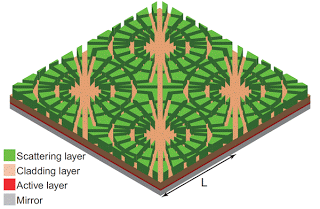Ad Support : Nano Technology Netbook Technology News Computer Software
This schematic diagram of a thin film organic solar cell shows the top layer, a patterned, roughened scattering layer, in green. The organic thin film layer, shown in red, is where light is trapped and electrical current is generated. The film is sandwiched between two layers that help keep light contained within the thin film.
Ultra-thin solar cells can absorb sunlight more efficiently than the thicker, more expensive-to-make silicon cells used today, because light behaves differently at scales around a nanometer (a billionth of a meter), say Stanford engineers. They calculate that by properly configuring the thicknesses of several thin layers of films, an organic polymer thin film could absorb as much as 10 times more energy from sunlight than was thought possible.
The key to overcoming the theoretical limit lies in keeping sunlight in the grip of the solar cell long enough to squeeze the maximum amount of energy from it, using a technique called “light trapping.” It’s the same as if you were using hamsters running on little wheels to generate your electricity – you’d want each hamster to log as many miles as possible before it jumped off and ran away.
If you go down to the nanoscales that we are interested in, hundreds of millionths of a millimeter in scale, it turns out the wave characteristic really becomes important.
Visible light has wavelengths around 400 to 700 nanometers (billionths of a meter), but even at that small scale, Fan said, many of the structures that Yu analyzed had a theoretical limit comparable to the conventional limit proven by experiment.
“One of the surprises with this work was discovering just how robust the conventional limit is,” Fan said.
It was only when Yu began investigating the behavior of light inside a material of deep subwavelength-scale – substantially smaller than the wavelength of the light – that it became evident to him that light could be confined for a longer time, increasing energy absorption beyond the conventional limit at the macroscale.
“The amount of benefit of nanoscale confinement we have shown here really is surprising,” said Yu. “Overcoming the conventional limit opens a new door to designing highly efficient solar cells.”
Yu determined through numerical simulations that the most effective structure for capitalizing on the benefits of nanoscale confinement was a combination of several different types of layers around an organic thin film.
He sandwiched the organic thin film between two layers of material – called “cladding” layers – that acted as confining layers once the light passed through the upper one into the thin film. Atop the upper cladding layer, he placed a patterned rough-surfaced layer designed to send the incoming light off in different directions as it entered the thin film.
By varying the parameters of the different layers, he was able to achieve a 12-fold increase in the absorption of light within the thin film, compared to the macroscale limit.
Nanoscale solar cells offer savings in material costs, as the organic polymer thin films and other materials used are less expensive than silicon and, being nanoscale, the quantities required for the cells are much smaller.
The organic materials also have the advantage of being manufactured in chemical reactions in solution, rather than needing high-temperature or vacuum processing, as is required for silicon manufacture.
PNAS – Fundamental limit of nanophotonic light trapping in solar cells
Establishing the fundamental limit of nanophotonic light-trapping schemes is of paramount importance and is becoming increasingly urgent for current solar cell research. The standard theory of light trapping demonstrated that absorption enhancement in a medium cannot exceed a factor of 4n2/ sin2θ, where n is the refractive index of the active layer, and θ is the angle of the emission cone in the medium surrounding the cell. This theory, however, is not applicable in the nanophotonic regime. Here we develop a statistical temporal coupled-mode theory of light trapping based on a rigorous electromagnetic approach. Our theory reveals that the conventional limit can be substantially surpassed when optical modes exhibit deep-subwavelength-scale field confinement, opening new avenues for highly efficient next-generation solar cells.
If you liked this article, please give it a quick review on Reddit, or StumbleUpon. Thanks
Supporting Advertising
Business Success
How to Make Money
Executive Jobs
Paid Surveys
Thank You

Brian Wang is a Futurist Thought Leader and a popular Science blogger with 1 million readers per month. His blog Nextbigfuture.com is ranked #1 Science News Blog. It covers many disruptive technology and trends including Space, Robotics, Artificial Intelligence, Medicine, Anti-aging Biotechnology, and Nanotechnology.
Known for identifying cutting edge technologies, he is currently a Co-Founder of a startup and fundraiser for high potential early-stage companies. He is the Head of Research for Allocations for deep technology investments and an Angel Investor at Space Angels.
A frequent speaker at corporations, he has been a TEDx speaker, a Singularity University speaker and guest at numerous interviews for radio and podcasts. He is open to public speaking and advising engagements.


